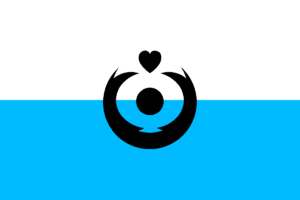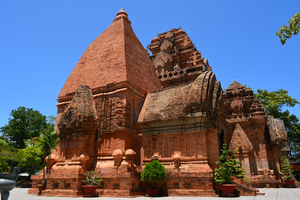Aschari
Aschari | |
|---|---|
 Flag of the Aschari people | |
| Total population | |
| ? | |
| Regions with significant populations | |
| Prei Meas, Zhousheng, Hrastmož, others | |
| Languages | |
| Aschari Language | |
| Religion | |
| Kammism |
The Aschari (ꦯꦹꦱꦹꦫꦷ in the Aschari language are people living in Eastern Prei Meas and historically spread all across the Northern Hagalaz Ocean. The Aschari can be further subdivided into a multitude of distinct clans who share similar cultures and dialects of the same Aschari language all being mutually intelligible.
Identity
The Aschari historically lived in a heavily nautical based society where children would learn how to make outrigger canoes, navigate with the stars, and fish from an early age. Some Kammist writings even claim that the Aschari were "hatched from sea turtle eggs". Unlike the rest of the region the Aschari have had a mainly matriarchal society where women would lead the home and lead the communities while the men would go to war, and fish. In addition the center of Aschari society are the families which are seen above everything and the groom would typically take the bride's family name.
Weaving
along side their naval prowess and expertise the Aschari are universally revered for their weaving and tapestries. Each clan and even family will have their own individual style of weaving tapestries and rugs each more intricate and eye catching than the last. These tapestries are seen as a symbol of their clan, a symbol of wealth, family heirlooms, to artwork and everything in between, and were among the many products sold by Aschari merchants.
regional identity
Aschari culture varies from region to region, an Aschari from Prei Meas would have largely different customs to an Aschari from Hrastmož. The Ascharis in general have a strong tradition of seafairing and families have their own customs, leading to differences from region to region in custom while beliefs remain relatively uniform.
Music and Dance
Dance
Many anthropologists point out similarities between Aschari traditional dances and Preimeai cultural dances, however, there are very distinct differences separating the two with little variation between Aschari peoples.
Matriachal Society
It is unclear how exactly Matrilineal social structure emerged in Aschari society, however, it is theorized that some of the cause was that while men were out fishing or sailing the wives would rule as chiefs in their own right staying in the village or settlements as Ipupuks. This theory is the most accepted due to how well it fits in with traditional clan positions with the leader being the female Ipupuk who would traditionally have her husband as banperestəwe (ꦧꦁꦤꦥꦼꦫꦼꦱꦠꦽꦮꦼ) who would be the leader for times of war and lead the sailors of the clan. As well as other customs like equality between individual males and females and just the families being passed through the female line.
clans
The Aschari people are largely matriarchal particularly in their clan and family structures. Traditionally while the men were raised to be warriors and merchants the women and mothers would govern the clans and instruct emissaries of their missions. These clan leaders would hold the title of Ipupuk (ꦯꦶꦥꦸꦥꦸꦏ) literally meaning "mother of the clan". Due to this clan structure to this day in Aschari society family names are passed on via the mother's line rather than the father's line.
Aschari Crests
The Adthochan more commonly referred to as Aschari Crests are a traditional type of symbol originally used to represent individual Aschari clans to fill a similar niche to heraldry.
Architecture
The Peak of Aschari architecture was roughly between the 900s CE- the early 13th century with there being many examples of Aschari architecture occurring far outside of this time window. Notably in the mid 1980s there was a small spike in a style of "Aschari Revivalism" architecture to bring back some of the old archicture as a part of the growing Cultural Revivalism in Prei Meas following the fall of the Kraham in the Preimeai Civil war. Aschari architecture is largely recognizable due to its usage of red sandstone decorated with fine reliefs and various sculptures, similar in some aspects to Preimeai architecture but with the red sandstone bricks being used.
History
Independent Aschara
The Kingdom of Aschara was not a traditional kingdom in the modern sense of the term but instead functioned as a loose confederation of independent and powerful cities. The largest and most powerful of these cities is the modern day city of Kanchanatang which to this day is one of the 3 largest cities in Prei Meas. In early history of Prei Meas the Aschari kingdom was the dominant power holding the various Preiemeai principalities as tributaries. It lasted well into the early modern period until the last independent Ashari coastal city state was conquered by Zhuosheng as the Empire of the Three Kings. The last true remnent of old Aschara would last on the island of Li'ude until it accepted Neuewland Protectorate Status and would later become absorbed into the larger Neuew colonization of Prei Meas.



